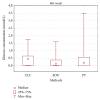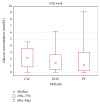Evaluation of the Sealing Ability of Three Obturation Techniques Using a Glucose Leakage Test
- PMID: 28706942
- PMCID: PMC5494785
- DOI: 10.1155/2017/2704094
Evaluation of the Sealing Ability of Three Obturation Techniques Using a Glucose Leakage Test
Abstract
The aim of this study was to evaluate the sealing ability of three different canal filling techniques. Sixty-four roots of extracted human maxillary anterior teeth were prepared using ProTaper® rotary instruments. The specimens were then randomly divided into 3 experimental groups (n = 16) and 2 control groups (n = 8). The root canals were filled using cold lateral compaction (CLC group), continuous wave condensation technique using the Elements Obturation Unit® (EOU group), and ProTaper obturators (PT group). For the negative control group, 8 roots were filled using lateral compaction as in the CLC group, and the teeth were covered twice with a layer of nail varnish (NCG group). Another 8 roots were filled using lateral compaction, but without sealer, and these were used as the positive control (PCG group). A glucose leakage model was used for quantitative evaluation of microleakage for 24 hours and 1, 2, 3, 4, 5, 6, 7, 8, 9, 10, 11, and 12 weeks. No significant difference in the cumulative amount of leakage was found between the three experimental groups at all observation times. The lateral condensation of cold gutta-percha can guarantee a similar seal of canal fillings as can be achieved by using thermal methods, in the round canals.
Figures







References
-
- Whitworth J. Methods of filling root canals: principles and practices. Endodontic Topics. 2005;12(1):2–24. doi: 10.1111/j.1601-1546.2005.00198.x. - DOI
-
- Haapasalo M., Udnaes T., Endal U. Persistent, recurrent, and acquired infection of the root canal system post-treatment. Endodontic Topics. 2003;6(1):29–56. doi: 10.1111/j.1601-1546.2003.00041.x. - DOI
MeSH terms
Substances
LinkOut - more resources
Full Text Sources
Other Literature Sources

